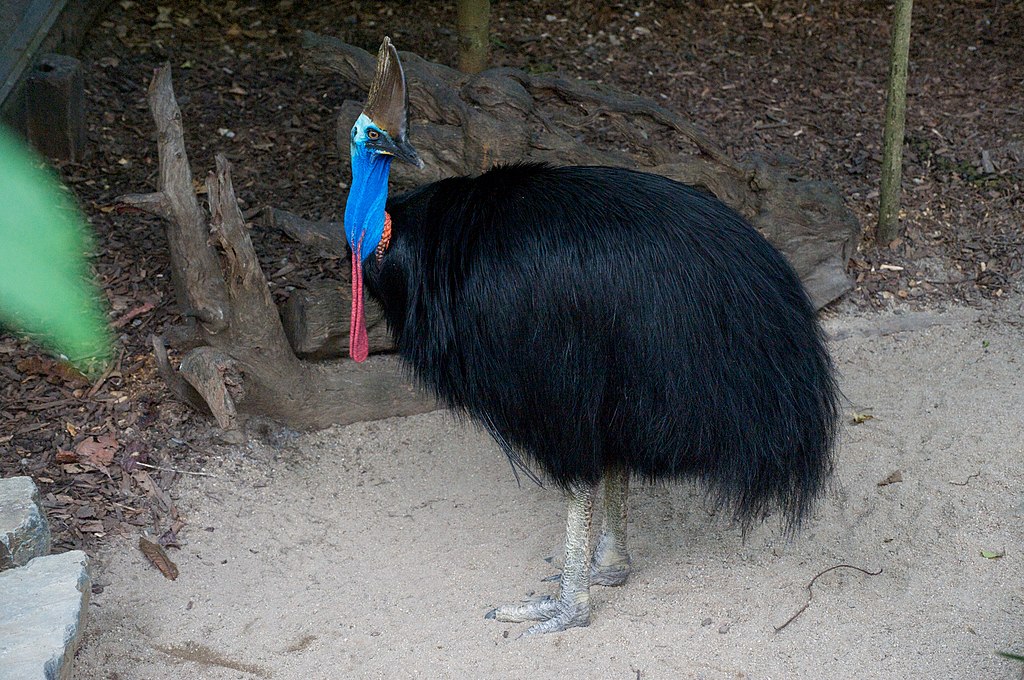Taxonomy
A female near Kuranda, Queensland, Australia
Cassowaries are closely related to the kiwis, both families diverging from a common ancestor approximately 40 million years ago.[3]
The binomial name Casuarius casuarius is derived from its Malay name kesuari.[4] The southern cassowary was first described by Carl Linnaeus in his 18th century work, Systema Naturae, as Struthio casuarius,[5] from a specimen from Seram, in 1758.[2] It is now the type species of the genus Casuarius.[2]
The southern cassowary has been described under a large number of scientific names, all of which are now considered taxonomic synonyms for the species.[6]
| [show]Synonyms |
|---|
Description
Detail of feet showing spearlike inner claw
Range and habitat
The southern cassowary is distributed in Indonesia, New Guinea and northeastern Australia,.[9] It mainly inhabits tropical rainforests but may make use of nearby savannah forests or mangroves stands.[1] The species prefers elevations below 1,100 m (3,600 ft) in Australia,[2] and 500 m (1,600 ft) on New Guinea.[1]| Location | Population | Trend |
|---|---|---|
| Southern Papua New Guinea | unknown | Declining |
| Seram | Unknown | Unknown |
| Aru Islands | Unknown | Unknown |
| Northeastern Australia | 1,500 to 2,500 | Declining |
| **Paluma Range | Unknown | Declining |
| **McIlwraith Range | 1000+ | Declining |
| **Jardine River National Park | Unknown | Unknown |
| Total | 2,500+ | Declining |
Behaviour
It forages on the forest floor for fallen fruit and is capable of safely digesting some fruits toxic to other animals. It also eats fungi, and some insects and small vertebrates. The southern cassowary is a solitary bird, which pairs only in breeding season, in late winter or spring. The male builds a nest on the ground,[2] a mattress of herbaceous plant material 5 to 10 centimetres (2–4 in) thick and up to 100 centimetres (39 in) wide. This is thick enough to let moisture drain away from the eggs. The male also incubates the eggs and raises the chicks alone. A clutch of three or four eggs are laid measuring 138 by 95 millimetres (5.4 in × 3.7 in). They have a granulated surface and are initially bright pea-green in colour although they fade with age.[2][10]Cassowaries make a booming call during mating season and hissing and rumblings otherwise. Chicks will make frequent high-pitches whistles to call the male.[1]
The blade-like claws are capable of killing humans and dogs if the bird is provoked.[11][12]
Conservation
Although subject to ongoing habitat loss, limited range, and overhunting in some areas, the southern cassowary as of 2017 evaluated as Least concern on the IUCN Red List of Threatened Species.[1] The Australian population is listed as Endangered under Federal and Queensland State legislation.[citation needed] Some threats are habitat loss (logging), feral animals eating their eggs, hunting, and roadkill.[1][2] Road building, feral animals and hunting are the worst of these threats. It has an occurrence range of 396,000 km2 (153,000 sq mi), and between 10,000 and 20,000 birds were estimated in a 2002 study, with between 1,500 and 2,500 in Australia.[1] Southern cassowaries have been bred in many zoos around the world, like at White Oak Conservation in Yulee, Florida, United States.[13]Gallery
-
Egg at Museum Wiesbaden
-
Chick at Artis Zoo, Netherlands









No comments:
Post a Comment
Note: Only a member of this blog may post a comment.